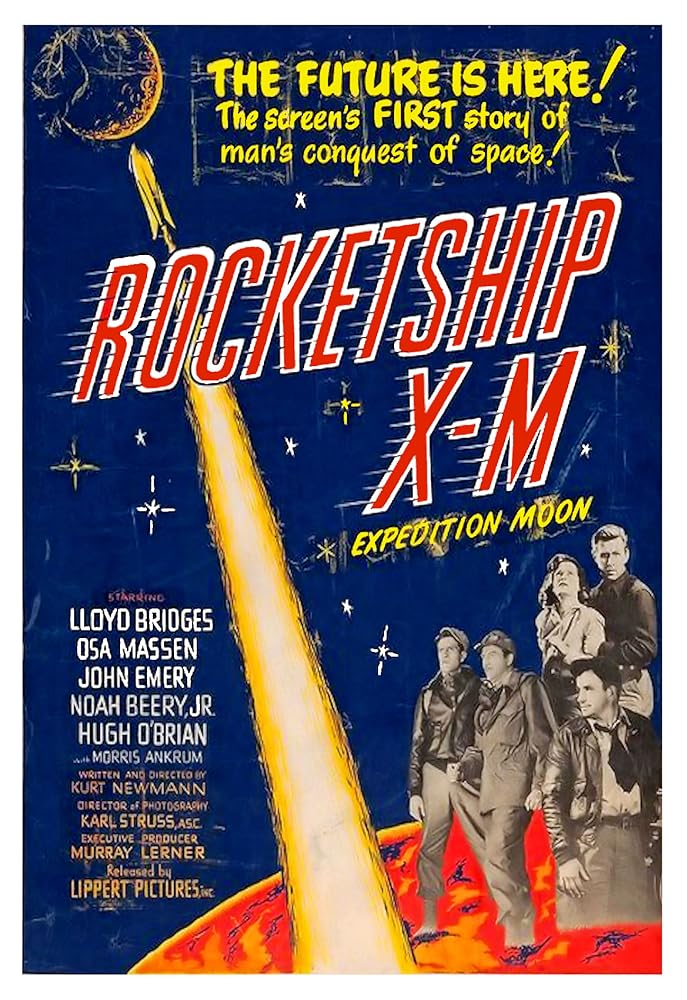
ROCKETSHIP X-M
(director/writer: Kurt Neumann; screenwriter: Orville Hampton/Dalton Trumbo; cinematographer: Karl Struss; editor: Harry Gerstad; music: Ferde Grofé; cast: Lloyd Bridges (Floyd Oldham, pilot), Osa Massen (Lisa Van Horn, chemist), John Emery (Karl Eckstrom, chief), Noah Beery Jr. (William Corrigan, engineer), Hugh O’Brien (Harry Chamberlin, radio man), Morris Ankrum (Dr. Fleming, project head); Runtime: 77; MPAA Rating: NR; producer: Kurt Neumann; Image Entertainment; 1950)
“The hokum sci-fi story is good for a few cheap laughs, as it takes itself so seriously until it goes all silly and then hits us with its bleak ending.”
Reviewed by Dennis Schwartz
The title signifies Expedition Moon in Kurt Neumann’s (“The Fly”/”Tarzan and the Amazons”/”Kronos”) landmark black-and-white sci-fi thriller, billed as the first space exploration film of the Atomic Age. It beats the release time of the larger budgeted George Pal’s Destination Moon by a few months. The marvel is that it’s made by cheapie Lippert Studio and is not all that bad (well, not really bad!), as was most every film they made except for The Steel Helmet and Baron of Arizona. German-emigre Kurt Neumann scripts it with Orville Hampton and an uncredited blacklisted writer named Dalton Trumbo. The hokum sci-fi story is good for a few cheap laughs, as it takes itself so seriously until it goes all silly and then hits us with its bleak ending.
The film is set in the near future. American project’s chief, Dr Fleming (Morris Ankrum), of the top secret government mission, holds a news conference to inform the world that five astronauts–the physicist flight chief, Karl Eckstrom (John Emery); the male chauvinist pig pilot, Colonel Floyd Oldham (Lloyd Bridges); the bland astronomer and radio man, Harry Chamberlin (Hugh O’Brien); the Texas-obsessed engineer, William Corrigan (Noah Beery Jr.) and the dour pretty lone woman, a fuel expert chemist, Lisa Van Horn (Osa Massen)–are about to embark on a pioneering mission to the moon.
Wouldn’t you know it, after blast off they accidentally get on the wrong course and land on Mars (that’s what you get for having a woman aboard a rocket in the early 1950s). Mars turns out to be bad news, because after they land on the red planet (to make sure the viewer knows this, a red tint appears during Mars sequences) and take a so-called walk in the park–they regrettably discover the desert terrain is a radioactive wasteland, the result of a catastrophic nuclear war which has reduced a once proud civilization to the Stone Age (I hope you get the not too subtle heavy-handed message delivered to the Cold War participants at the start of the space race and nuclear arms build-up).
My favorite film moment is Bridges coming onto Osa by telling the science brain: “Why does a woman need to go on space trips and fill her pretty little head with facts and figures for?” Osa coolly responds: “Maybe you think I should be a homemaker, cooking and having babies.” Floyd shoots back with a sinister smile on his kisser: “Isn’t that enough?” Naturally, by the journey’s end, these two become romantically involved forever–it’s that kind of a movie.
REVIEWED ON 2/13/2007 GRADE: B-